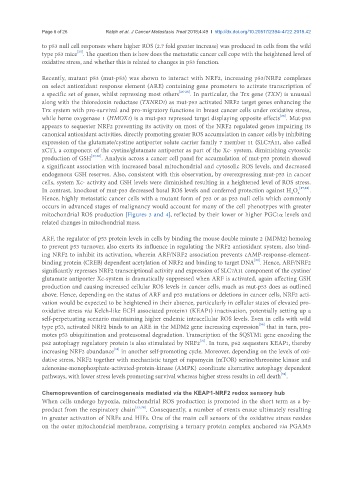Page 586 - Read Online
P. 586
Page 6 of 26 Ralph et al. J Cancer Metastasis Treat 2018;4:49 I http://dx.doi.org/10.20517/2394-4722.2018.42
to p53 null cell responses where higher ROS (2.7 fold greater increase) was produced in cells from the wild
[25]
type p53 mice . The question then is how does the metastatic cancer cell cope with the heightened level of
oxidative stress, and whether this is related to changes in p53 function.
Recently, mutant p53 (mut-p53) was shown to interact with NRF2, increasing p53/NRF2 complexes
on select antioxidant response element (ARE) containing gene promoters to activate transcription of
a specific set of genes, whilst repressing most others [26-28] . In particular, the Trx gene (TXN) is unusual
along with the thioredoxin reductase (TXNRD1) as mut-p53 activated NRF2 target genes enhancing the
Trx system with pro-survival and pro-migratory functions in breast cancer cells under oxidative stress,
[26]
while heme oxygenase 1 (HMOX1) is a mut-p53 repressed target displaying opposite effects . Mut-p53
appears to sequester NRF2 preventing its activity on most of the NRF2 regulated genes impairing its
canonical antioxidant activities, directly promoting greater ROS accumulation in cancer cells by inhibiting
expression of the glutamate/cystine antiporter solute carrier family 7 member 11 (SLC7A11, also called
xCT), a component of the cystine/glutamate antiporter as part of the Xc- system, diminishing cytosolic
production of GSH [27,28] . Analysis across a cancer cell panel for accumulation of mut-p53 protein showed
a significant association with increased basal mitochondrial and cytosolic ROS levels, and decreased
endogenous GSH reserves. Also, consistent with this observation, by overexpressing mut-p53 in cancer
cells, system Xc- activity and GSH levels were diminished resulting in a heightened level of ROS stress.
In contrast, knockout of mut-p53 decreased basal ROS levels and conferred protection against H O 2 [27,28] .
2
Hence, highly metastatic cancer cells with a mutant form of p53 or as p53 null cells which commonly
occurs in advanced stages of malignancy would account for many of the cell phenotypes with greater
mitochondrial ROS production [Figures 3 and 4], reflected by their lower or higher PGC1α levels and
related changes in mitochondrial mass.
ARF, the regulator of p53 protein levels in cells by binding the mouse double minute 2 (MDM2) homolog
to prevent p53 turnover, also exerts its influence in regulating the NRF2 antioxidant system, also bind-
ing NRF2 to inhibit its activation, wherein ARF/NRF2 association prevents cAMP-response-element-
[29]
binding protein (CREB) dependent acetylation of NRF2 and binding to target DNA . Hence, ARF/NRF2
significantly represses NRF2 transcriptional activity and expression of SLC7A11 component of the cystine/
glutamate antiporter Xc-system is dramatically suppressed when ARF is activated, again affecting GSH
production and causing increased cellular ROS levels in cancer cells, much as mut-p53 does as outlined
above. Hence, depending on the status of ARF and p53 mutations or deletions in cancer cells, NRF2 acti-
vation would be expected to be heightened in their absence, particularly in cellular states of elevated pro-
oxidative stress via Kelch-like ECH associated protein1 (KEAP1) inactivation, potentially setting up a
self-perpetuating scenario maintaining higher endemic intracellular ROS levels. Even in cells with wild
[30]
type p53, activated NRF2 binds to an ARE in the MDM2 gene increasing expression that in turn, pro-
motes p53 ubiquitination and proteasomal degradation. Transcription of the SQSTM1 gene encoding the
[31]
p62 autophagy regulatory protein is also stimulated by NRF2 . In turn, p62 sequesters KEAP1, thereby
[31]
increasing NRF2 abundance in another self-promoting cycle. Moreover, depending on the levels of oxi-
dative stress, NRF2 together with mechanistic target of rapamycin (mTOR) serine/threonine kinase and
adenosine-monophosphate-activated-protein-kinase (AMPK) coordinate alternative autophagy dependent
[32]
pathways, with lower stress levels promoting survival whereas higher stress results in cell death .
Chemoprevention of carcinogenesis mediated via the KEAP1-NRF2 redox sensory hub
When cells undergo hypoxia, mitochondrial ROS production is promoted in the short term as a by-
product from the respiratory chain [33,34] . Consequently, a number of events ensue ultimately resulting
in greater activation of NRFs and HIFs. One of the main cell sensors of the oxidative stress resides
on the outer mitochondrial membrane, comprising a ternary protein complex anchored via PGAM5

